If there was a prize going for the cutest aquarium addition of all time, the Pea Puffer would certainly be the winner.
These adorable little dwarf fish are right at home in a small aquarium and they have lots of unique traits that have earned them a spot in so many tanks around the world.
How do you look after a Pea Puffer?
The Pea Puffer is generally considered a low-maintenance fish to keep but it requires the right tankmates and conditions. The species is highly regarded for its swift movements and cute look and is a good choice for beginner to expert aquarists.
These puffy fish are one of the quirkiest species you could place in a tank, but taking care of them requires diligence.
If you’ve been thinking about introducing a Pea Puffer to your existing aquarium and want to know what’s involved in their care, this guide will answer all of your pertinent questions.
Contents
What is a Pea Puffer?
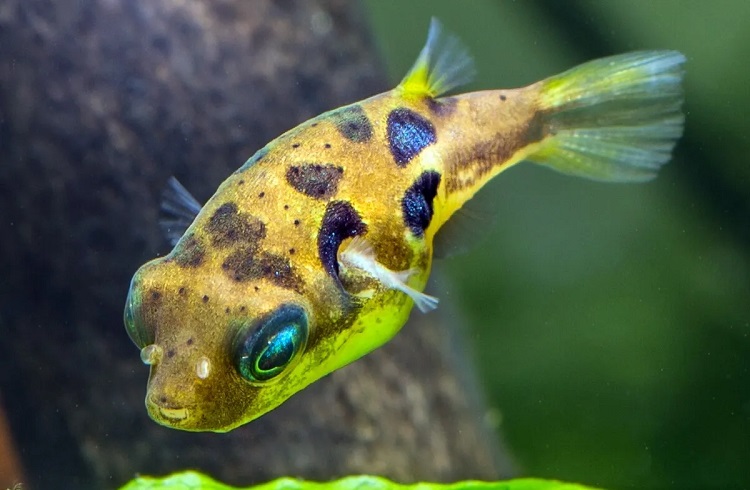
A Pea Puffer is a species of pufferfish known as the Carinotetraodon travancoricus and it’s commonly refered to as the Dwarf Pufferfish, Pygmy Pufferfish, Drawf Pea Puffer, and Mablaber Pufferfish.
These compact fish have become popular for hobby aquarists because of their good lifespan, beautiful appearance, and intelligent and inquisitive nature.
The Dwarf or Pea Puffer originates from Southwest India, and it inhabits waterways like lakes, rivers, and estuaries. Regardless of where it’s swimming, the temperature is always warm, and they frequent waters with an average temperature of 77 degrees Fahrenheit ranging up to as high as 92 degrees.
Although they live in brackish waters sometimes, they’re not fast swimmers, and they won’t do well if you try to replicate these conditions in a tank. They need at least 12 hours of sunlight or artificial light each day, but during winter this can come down to around 10.5 hours.
At home, they live amongst a lot of varied plant life, and ensuring your tank has this for them as well, is essential.
Appearance and Characteristics
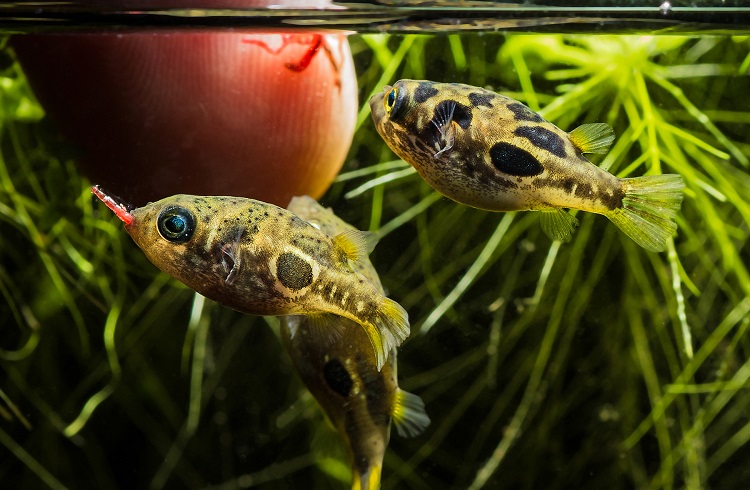
The Dwarf Pea Puffer is compact fish species with a maximum length of around 1.4 inches, and it’s one of the smallest of all of the pufferfish family.
They have the signature round body with a thinner backside and large eyes that are disproportionate to the rest of them, both of which give them the adorable look that so many people have fallen in love with.
The male Pea Puffer will have a bright yellow belly and dark stripe, with a golden green color all over. The female has a white-yellow belly and a lighter yellow-green color, and no stripe. Both sexes sometimes feature spots across their body, but others will show no spots at all.
Their vibrant colors and markings make it easy to sex them as they mature, but it can be difficult when they’re still young. As care must be taken not to mix too many males together in a tank, you’ll want to be sure you’re buying the correct gender before you equip your aquarium with a Pea Puffer.
Behavioral Traits of the Pea Puffer
As a whole, the Pea Puffer species is known as a timid and intelligent fish.
However, when they’re grouped with others, this behavior can quickly change.
Male pufferfish are known to be aggressive towards each other, and if you plan on keeping more than one, you’ll want to get the male to female ratio right.
One of the reasons for the Pea Puffer’s popularity, aside from its good looks, is its naturally inquisitive nature.
Owners of these fish find that they spend a lot of time exploring their surroundings inside and outside of the tank, and start to learn routines like feeding time or when the tank is to be cleaned.
Puffer Tank Conditions
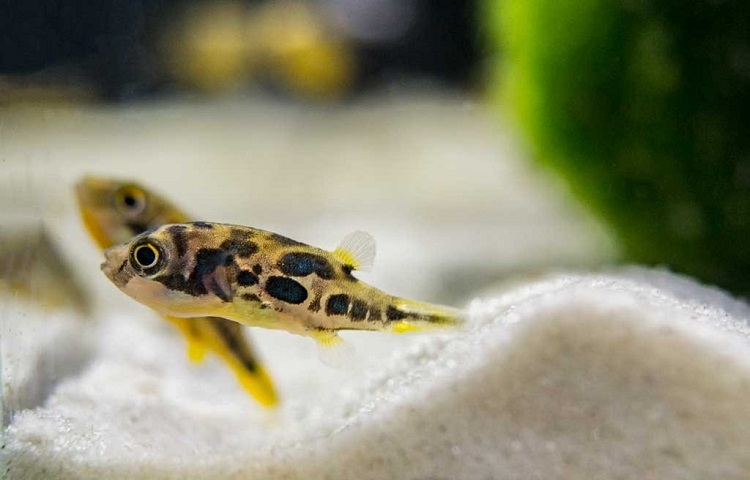
A fish can only thrive in the right conditions, and when the Pea Puffer is concerned, you’ll want to get this right.
The size of a tank is the first aspect, with experts recommending five gallons of water for one puffer, and an additional three gallons of water for each additional puffer you add to the mix.
The tank should have a lot of plants and be dense, with plenty of coverage and places for them to hide, allowing you to keep up to three of the fish in a 10-gallon tank. Otherwise, you’ll be seeing a lot of fighting going on between the Pea Puffers in your aquarium.
To get the ideal temperature for the Pea Puffer, you’ll want to try and replicate the tropical waters they love, so anything between 74 to 82 degrees Fahrenheit is perfect.
Those living in colder areas or your room temperature fluctuates will need to invest in aquarium heater, as this fish won’t do well in anything outside of their usual climate, and any filtration should be gentle because they’re slow-paced fish.
The water should be measuring at pH levels between 6.5 and 8.4, with somewhere right in the middle being the perfect level.
What’s most important with these fish though, is keeping that level stable, even if it’s on the lower or higher end of the recommended pH scale.
Feeding a Pea Puffer
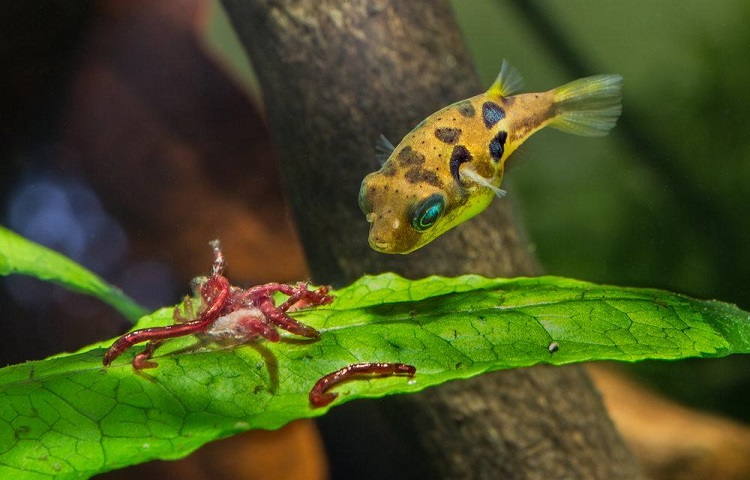
In their natural habitat of lakes and rivers, the carnivorous Pea Puffer will feed on all manner of things, including water fleas, larvae, microscopic algae, and insects.
When you’re keeping them at home in an aquarium, they should get a good variety of live and frozen foods to ensure they’re happy and full of the right nutrients.
A Pea Puffer should be fed twice a day, morning and night, with care being taken not to overfeed them. As one of the smarter fish species, you’ll notice that after some time, your Pea Puffer starts to perk up when they recognize you’ve come into the room to feed them, which makes owning one even more spectacular.
Pea Puffer owners sometimes fall into the trap of overfeeding these fish because they can act as if they’re still hungry, even after the food is gone. As a goal, you should provide them with enough food to feed them for three full minutes, and anything after that will be too much.
When overfeeding any type of fish, you’ll notice an increase in nitrate levels in the tank, which will cause an overgrowth of algae, so it must be avoided.
A good combination of foods should be on hand for your Pea Puffer, including small shrimps, snails, and specially formulated fish food.
Although they won’t eat the algae from the tank, they do appreciate treats like algae wafers occasionally.
Ideal Tankmates for the Pea Puffer
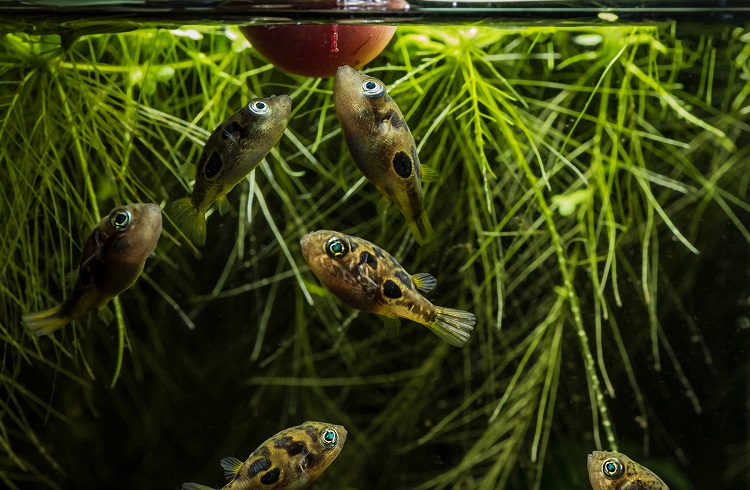
Pea Puffers have mixed reactions to other types of fish, but it’s more their own species that you have to be concerned about.
If you plan on having more than one of these in a tank, you’ll want one male with two or three females, as this reduces aggression. What makes this difficult is when they’re sold so young, they can be hard to sex, so choosing an adult fish might be better.
In regards to other fish species, the Pea Puffer doesn’t do that well and can come off as aggressive and territorial. For those hoping to get a mixed-species aquarium, you might want to choose another type of fish to live there as the puffer doesn’t like to share their space.
If you want to create a community tank and are adamant that your Pea Puffer takes part in it, it’s best to choose small and fast fish species like Neon Tetras, Zebra Danio, and Filament Bard. As the Pea Puffer is small and slow, it won’t be able to attack these, nor will it be at risk of the attack itself.
One of the issues with keeping only Pea Puffers on their own is that you won’t be able to have other fish or snails that clean the algae from the tank, so extra care will need to be taken with their maintenance.
This is compounded by the fact that the puffer is notoriously messy when it eats, so you’ll want to increase the plant presence even further, which in turn will benefit the behavior of these fish as well.
The Best Aquariums for This Fish Species
The Pea Puffer is usually one of the first on the list for people looking for a cute pet, but they require extra care and maintenance that means they’re not right for everyone.
This species would be better suited to someone with an intermediate knowledge of aquariums and fish, otherwise, they might be exposed to stress and improper living conditions.
A Pea Puffer has a lifespan of around four years so if they’re cared for correctly, they last quite a while. However, you’ll need to keep them in a species only tank and make sure you have the correct ratio of male to female fish, as well as lots of green places for them to hide, or it could be carnage.
When dealing with unique species like the Pea Puffer, aquarists should take care when purchasing a new fish. This species has been classed as vulnerable and may even become endangered, partly because of the high demand for these fish from hobbyists. With this in mind, you should avoid wild-caught pufferfish to reduce this negative impact.
If you want an even lower maintenance tank for your Pea Puffers, these fish would do better in an already tropical climate. Otherwise, you’ll need to manage the temperature with a heater and ensure to keep it in the sweet spot.
However, for all of this extra work, you’ll be rewarded with one of the cutest and most entertaining fish species there is to own.
Pea Puffer Perfection

There are few fish species out there that can claim to be as cute as the Pea Puffer and with all of the joy they bring to the average tank, it’s easy to see how they became so popular.
With a little bit of thoughtful planning, intermediate knowledge of aquariums, and the right conditions, you’ll get hours of joy from watching this beautiful fish swim around at home.
Related Questions
Any time you introduce a new fish to your tank, you want to make sure you’ve done your research to see that they’ll be a good fit.
Whether it’s the Pea Puffer or another cute species, there’s a lot to learn, so we’ve answered some FAQs about home aquariums that might be able to help.
How Long Do You Wait to Put Fish in a New Tank?
After setting up a tank, you’ll need to wait for the ammonia and nitrite levels to rise and then fall again back to zero before you can add any fish to the water.
In some cases, this could take up to six weeks, so you have to be patient, and once it’s ready, you’ll only want to add a few fish each week to take it slow.
Can I Add Water Conditioner While the Fish Are in the Tank?
Most water conditioner products are safe to add to the tank while the fish are still in it, so there’s no need to remove them first.
However, if you’re dealing with an already overcrowded tank, it’s best to take the fish out and let the conditioner diffuse equally around it before placing them back in.
How Long Do Fish Stay in Their Bag?
If you’re bringing fish home in a bag, you’ll want to place it into the aquarium as soon as you get home and leave them there for 30 minutes before emptying them into the tank’s water.
This enables the water in the bag to acclimate to the temperature of the tank so that there’s no shock for the fish when it’s moved.

Ian Sterling, founder of Fishlab.com, began his aquarium journey over 30 years ago, driven by a deep fascination for fish and their diverse personalities. His website, Fishlab.com, is dedicated to making fishkeeping accessible and enjoyable, offering beginner-friendly guidance, expert insights, and a community for aquarists to connect and share experiences.


